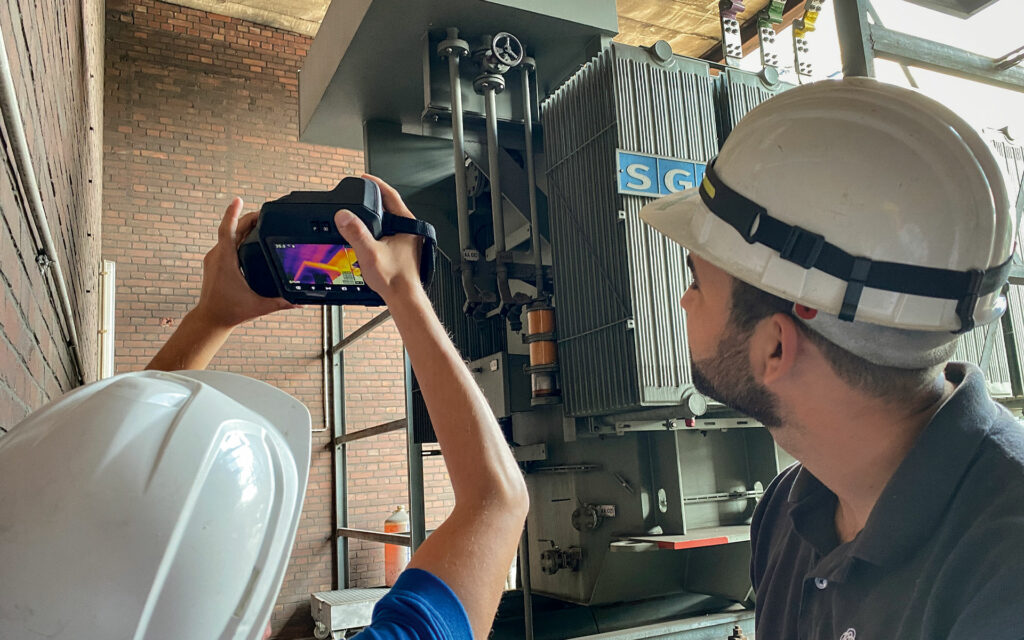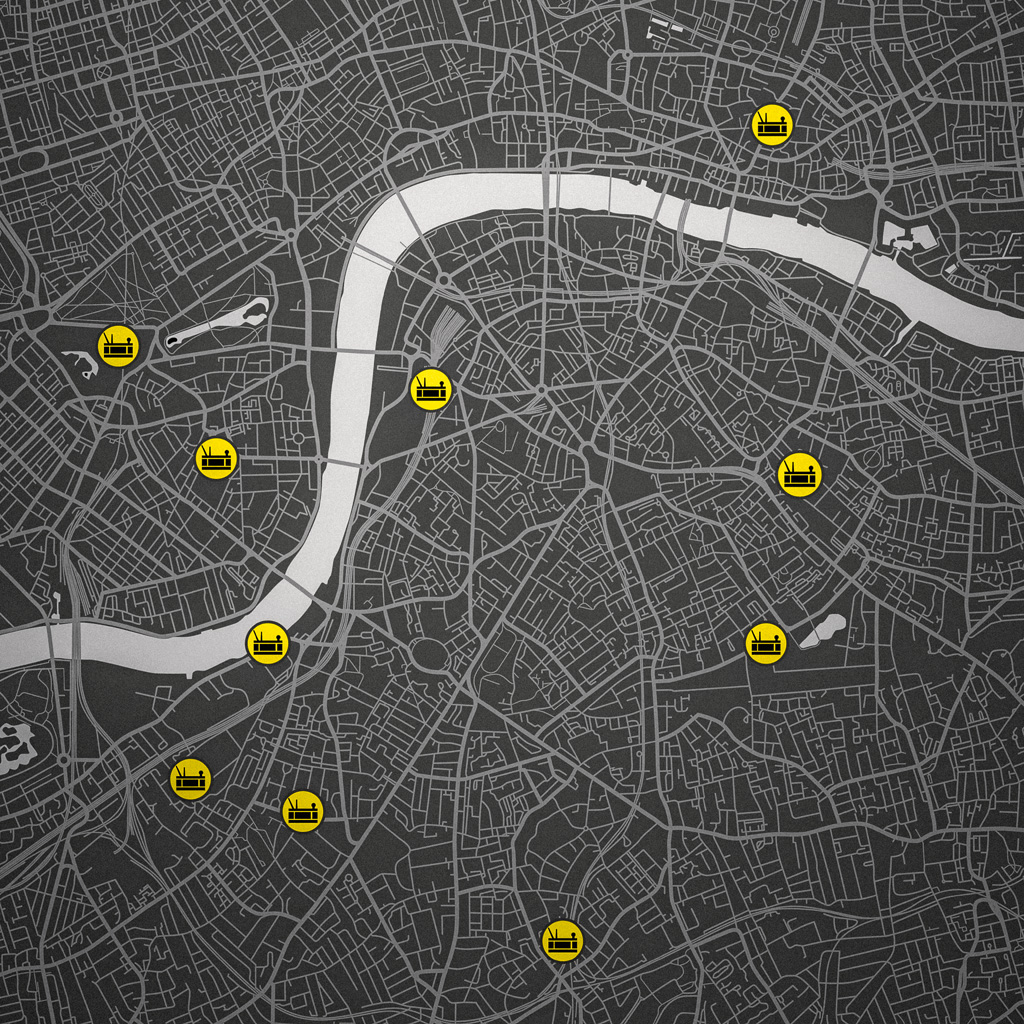Sustainability goes hand in hand with longevity. That’s why the thyssenkrupp steelworks in Duisburg was visited by MR’s FLEETSCAN 2D specialists, who explained the process of the service — which puts transformers through their paces — in a training session.
Steel is a building material that runs through our entire lives. Most steelworks have been around since industrialization and their material can be recycled with almost no loss. Steel is also essential for the energy transition—be it for the construction of electric motors or wind farms. But for its production to meet the requirements of the energy transition, it must become sustainable. thyssenkrupp operates Europe’s largest steelworks near Duisburg and is actively working on the future sustainability of its production.
“This not only includes sourcing more and more electricity from renewable sources,” explains Fabian Marquardt, Engineer High Voltage Technology and Grid Planning, “thyssenkrupp Steel is currently undergoing a transformation towards CO2-free steel production at our site in Duisburg. This strategy also includes ensuring the longevity of our own equipment by expanding preventive maintenance in a targeted manner.”


TESSA® FLEETSCAN 2D is designed to help with this. Using this digital consulting approach from MR, the specialists first record a large amount of measurement data from the operating equipment and then evaluate it. This creates a detailed picture of the condition of the assets in terms of two dimensions: the risk of failure and lifetime consumption. The failure risk index is aimed at service managers and looks to the immediate future, while the service-life consumption index is aimed at asset managers and their budgets for long-term planning decisions.
Together they serve to develop a maintenance strategy based on the condition of a fleet. Repeated at intervals of one to three years, TESSA® FLEETSCAN 2D provides an accurate picture of the condition of the equipment, which can be seen at a glance using the associated software.

Since the evaluation is only as good as the previously measured data, the MR specialists normally collect this data themselves at the customer’s premises. In Duisburg, however, they took a different approach, explains Philipp Birgmeier, Technical Consultant in the Service department: “thyssenkrupp has very well-trained specialists and wanted to read out the transformer data themselves. That’s why we held a two-day training course on site which will enable the specialists to inspect their equipment based on our specifications, and collect the data necessary for our subsequent evaluation.” Marquardt adds: “The previous assessment aspects such as oil analyses or electrical measurements are combined and supplemented by the standardized visual inspection. In this way, we ensure that the budget is used in the right places and that new acquisitions are initiated in good time despite long delivery times.”
LEARNING THE THEORY
In the training, the thyssenkrupp specialists were first taught some theory. “On the first day, we explained the data collection to them and my colleague Nina Machnikowski from Development supported the participants in installing and using the TESSA® FLEETSCAN 2D web application,” says Birgmeier. Users can later save the measured data and associated documents via the app and retrieve them at any time, as well as check the values of the evaluation carried out.

The next day was all about practice: after repeating the theory, the engineers and technicians collected the data on two transformers using thermal imaging cameras and the additional expertise of the MR professionals. Birgmeier explains: “This included learning to read the thermal images which are non-contact, non-destructive imaging in real time, so they can be taken during operation and provide great insight into the condition of the equipment if you know what to look out for.” The aim here is to create a standardized evaluation system.”
Trained in this way, thyssenkrupp employees were able to record and enter the relevant transformer data themselves over the following few weeks which was then sent to MR together with documents from previous measurements. “We then evaluate everything and write a detailed inspection report for each transformer as well as a fleet report that assesses the condition of all assets as a whole,” explains Birgmeier, who is very satisfied with the pilot project. “We can well imagine establishing this procedure with other customers. The training has shown us that this type of know-how transfer works well.”
“Our technicians and maintenance staff were enthusiastic about the practical training.”
Fabian Marquardt, Engineer High Voltage Technology and Grid Planning, thyssenkrupp
Marquardt agrees: “Our technicians and maintenance staff were enthusiastic about the practical training. The core objective was to teach them how to use the tool to enable them to carry out visual inspections, and it was very important to us that the tool was easy to use on the individual end devices. The test evaluations carried out met all objectives, and all questions that arose were answered immediately.”
PRACTICAL IMPLEMENTATION
Once the reports are ready, technicians can also view them in the app at any time. In addition to showing the conditions, they also contain clear and prioritized recommendations for maintenance and repair of the individual units. If TESSA® FLEETSCAN 2D is repeated in a few years, this will make the forecasts and recommendations even more accurate.
But why is such a detailed review of operating equipment so important? In Duisburg, the steelworks fleet consists of a total of 68 medium-voltage and high-voltage transformers that supply the plant and especially the smelter with energy. Some of these transformers are already at an advanced age. However, new purchases are currently quite difficult because delivery times for both new transformers and special components are between two and four years, depending on the model, manufacturer and intended purpose.

“A sudden failure means a high financial risk, especially in industry,” explains Birgmeier. Due to the high priority of the infrastructure, it is common practice for network operators to carry out meticulous maintenance and keep reserve transformers ready so that the power supply is guaranteed at all times. In industry, however, this is not possible for all assets, and transformers are replaced only as required. In some countries, there is a trend towards operating transformers under higher loads and replacing them in good time, but this no longer works given the current delivery times, and it is also not a particularly sustainable approach.
For the steelworks in Duisburg, these long delivery times mean going the extra mile in terms of maintenance and condition analysis and keeping a constant eye on the assets even during operation. “The right sensor technology is also crucial for this,” says Marquardt “and this is where we rely on online hydrogen detection with the MSENSE® DGA2 sensors from MR which detect creeping increases in the hydrogen content in the oil at an early stage and help to avoid serious faults in the transformer. The aim is to enable the fault in the transformer station to be repaired at short notice instead of suffering a total loss. It was good that we received an early and competent overview of the new TESSA® FLEETSCAN 2D and MSENSE® DGA2 sensor technology via long-standing MR sales contact Werner Sammet.”
TESSA® FLEETSCAN 2D OFFERS
• Customized data acquisition
• Condition assessment regarding risk of failure and lifetime consumption
• Fleet condition at a glance
• Early detection of critical units
• Clear recommendations for action
• Structured web app with offline data input

YOUR CONTACT
Do you have any questions about TESSA® FLEETSCAN 2D? The sales department at MR is there for you:
sales@reinhausen.com


